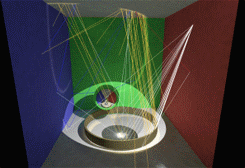Traditional rendering implies computation of
realistic images given a standard 3D scene description. Scene
description is a quadruple: geometry, light sources, materials,
virtual camera. Though the problem with such formulation is being
attacked by graphics community for quite a long time, the
performance of currently developed algorithms is still too low for
many practical applications. We contribute to overall progress in
this area by suggesting new algorithms, based on novel numerical
methods, as well as better suited for modern hardware.

Photo realistic images synthesis is one of the
central problems of traditional rendering. One of the ways to
achieve realism is to apply physically based algorithms, which
implies modeling of light interaction with scene objects, basing on
the laws of physics. If the modeled light behavior corresponds to
it's behavior in the real life, the received images are guaranteed
to look realistic. However, such modeling can be computationally
expensive. The rise of computing power solves this problem only
partially because complexity of the processed virtual scenes
increases as well. Thus, there is a vital need to improve the
performance of all related algorithms. So far our main efforts in
this area were concentrated on the following issues: improvement of
ray tracing speed [1], extending traditionally used Phong material
model to handle fuzzy reflections [2], use of quasi-Monte Carlo
algorithm in the general setting to increase the convergence of
Global Illumination algorithms [3], visualization of rays in
(quasi-)Monte Carlo algorithms for debugging, promotional and
educational purposes [4].Here are some images,
which demonstrate our results:




[1] Dmitriev K. Efficiency issues on ray tracing
machine. // Graphicon '2000 conference proceedings, Moscow, Russia,
August 25 - September 1, 2000, pp. 99-103.
[2] Kulikova A. and Dmitriev K. Fuzzy reflections
rendering. Fuzzy reflections rendering. // Graphicon '2001
conference proceedings, N.Novgorod, Russia, August 25 - September 1,
2001, pp. 88-9.
[3] Dmitriev K. From Monte Carlo to quasi-Monte
Carlo. // Graphicon '2002 conference proceedings, N.Novgorod,
Russia, September 21-26, 2000.
[4] Kopylov E. and Dmitriev K. Light propagation
visualization as a tool for 3d scene analysis in lighting design. //
Computers & Graphics, Elsevier Science, vol. 24, num. 1, 2000,
pp.31-39.

Traditionally OpenGL or DirectX APIs are used for
rendering in interactive applications. Those APIs are fairly limited
in the number of directly supported effects, which significantly
reduces the images realism. We have developed a number of
algorithms, which improve the realism by modeling lacking effects
via modern hardware accelerators. This includes:
-
shadows from multiple light sources;
-
reflections;
-
general surface BSDFs (Bi-directional Scattering
Distribution Functions);
-
lights with general intensity distributions;
Those effects are demonstrated by the below images,
received exclusively using graphics hardware:




Currently only the use of graphics hardware allows
to achieve interactive speed of rendering. Received images, however,
often lack the physical accuracy required for many applications. One
of the reasons is that hardware computes only direct lighting,
leaving important indirect lighting effects without attention. We
have developed a general Monte-Carlo framework, which is able to
work both standalone, and in cooperation with graphics hardware.
This framework is specifically designed for interactive applications
and allows to update the global illumination rather then recompute
it from the scratch after scene changes. This project is was
performed in cooperation with Max-Planck Institute for Computer
Science (http://www.mpi-sb.mpg.de/) and
current results are published in [5].
[5] Dmitriev K., Brabec S., Myszkowski K.,
and Seidel H.-P. Interactive global illumination using selective
photon tracing. In Debevec P. and Gibson S., editors, // Rendering
Techniques '2002 (Springer), Pisa, Italy, June 26-28, 2002, pp.
100-113.